Coping with Grief Through Worden's Tasks
VerifiedAdded on 2020/02/19
|9
|2658
|246
AI Summary
This assignment delves into John Worden's theory of the Four Tasks of Mourning. It outlines each task: accepting the reality of the death, processing the pain of grief, adjusting to a world without the deceased, and maintaining an enduring connection with them. The assignment emphasizes the importance of these tasks in achieving healthy emotional well-being after loss and provides practical strategies for navigating each stage.
Contribute Materials
Your contribution can guide someone’s learning journey. Share your
documents today.
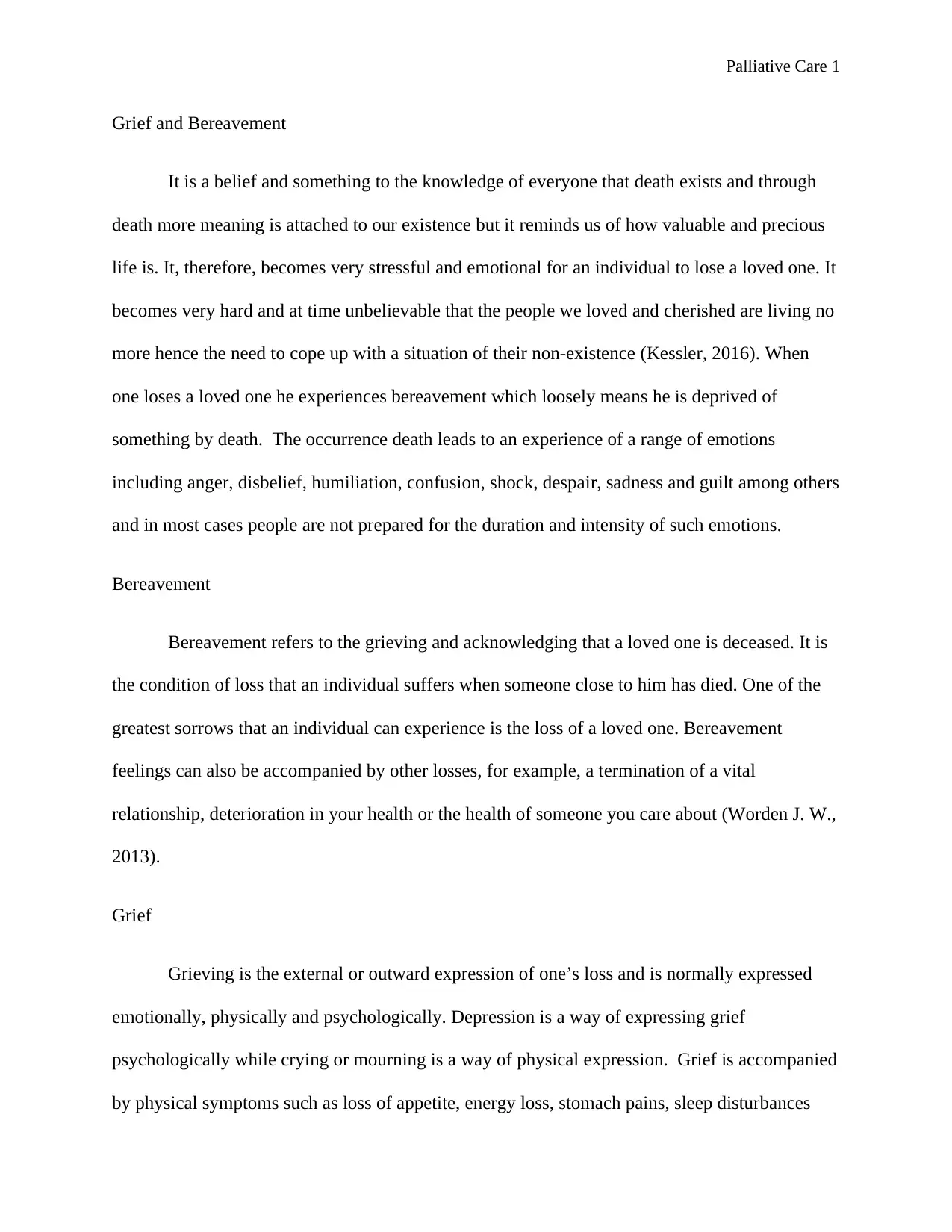
Palliative Care 1
Grief and Bereavement
It is a belief and something to the knowledge of everyone that death exists and through
death more meaning is attached to our existence but it reminds us of how valuable and precious
life is. It, therefore, becomes very stressful and emotional for an individual to lose a loved one. It
becomes very hard and at time unbelievable that the people we loved and cherished are living no
more hence the need to cope up with a situation of their non-existence (Kessler, 2016). When
one loses a loved one he experiences bereavement which loosely means he is deprived of
something by death. The occurrence death leads to an experience of a range of emotions
including anger, disbelief, humiliation, confusion, shock, despair, sadness and guilt among others
and in most cases people are not prepared for the duration and intensity of such emotions.
Bereavement
Bereavement refers to the grieving and acknowledging that a loved one is deceased. It is
the condition of loss that an individual suffers when someone close to him has died. One of the
greatest sorrows that an individual can experience is the loss of a loved one. Bereavement
feelings can also be accompanied by other losses, for example, a termination of a vital
relationship, deterioration in your health or the health of someone you care about (Worden J. W.,
2013).
Grief
Grieving is the external or outward expression of one’s loss and is normally expressed
emotionally, physically and psychologically. Depression is a way of expressing grief
psychologically while crying or mourning is a way of physical expression. Grief is accompanied
by physical symptoms such as loss of appetite, energy loss, stomach pains, sleep disturbances
Grief and Bereavement
It is a belief and something to the knowledge of everyone that death exists and through
death more meaning is attached to our existence but it reminds us of how valuable and precious
life is. It, therefore, becomes very stressful and emotional for an individual to lose a loved one. It
becomes very hard and at time unbelievable that the people we loved and cherished are living no
more hence the need to cope up with a situation of their non-existence (Kessler, 2016). When
one loses a loved one he experiences bereavement which loosely means he is deprived of
something by death. The occurrence death leads to an experience of a range of emotions
including anger, disbelief, humiliation, confusion, shock, despair, sadness and guilt among others
and in most cases people are not prepared for the duration and intensity of such emotions.
Bereavement
Bereavement refers to the grieving and acknowledging that a loved one is deceased. It is
the condition of loss that an individual suffers when someone close to him has died. One of the
greatest sorrows that an individual can experience is the loss of a loved one. Bereavement
feelings can also be accompanied by other losses, for example, a termination of a vital
relationship, deterioration in your health or the health of someone you care about (Worden J. W.,
2013).
Grief
Grieving is the external or outward expression of one’s loss and is normally expressed
emotionally, physically and psychologically. Depression is a way of expressing grief
psychologically while crying or mourning is a way of physical expression. Grief is accompanied
by physical symptoms such as loss of appetite, energy loss, stomach pains, sleep disturbances
Secure Best Marks with AI Grader
Need help grading? Try our AI Grader for instant feedback on your assignments.
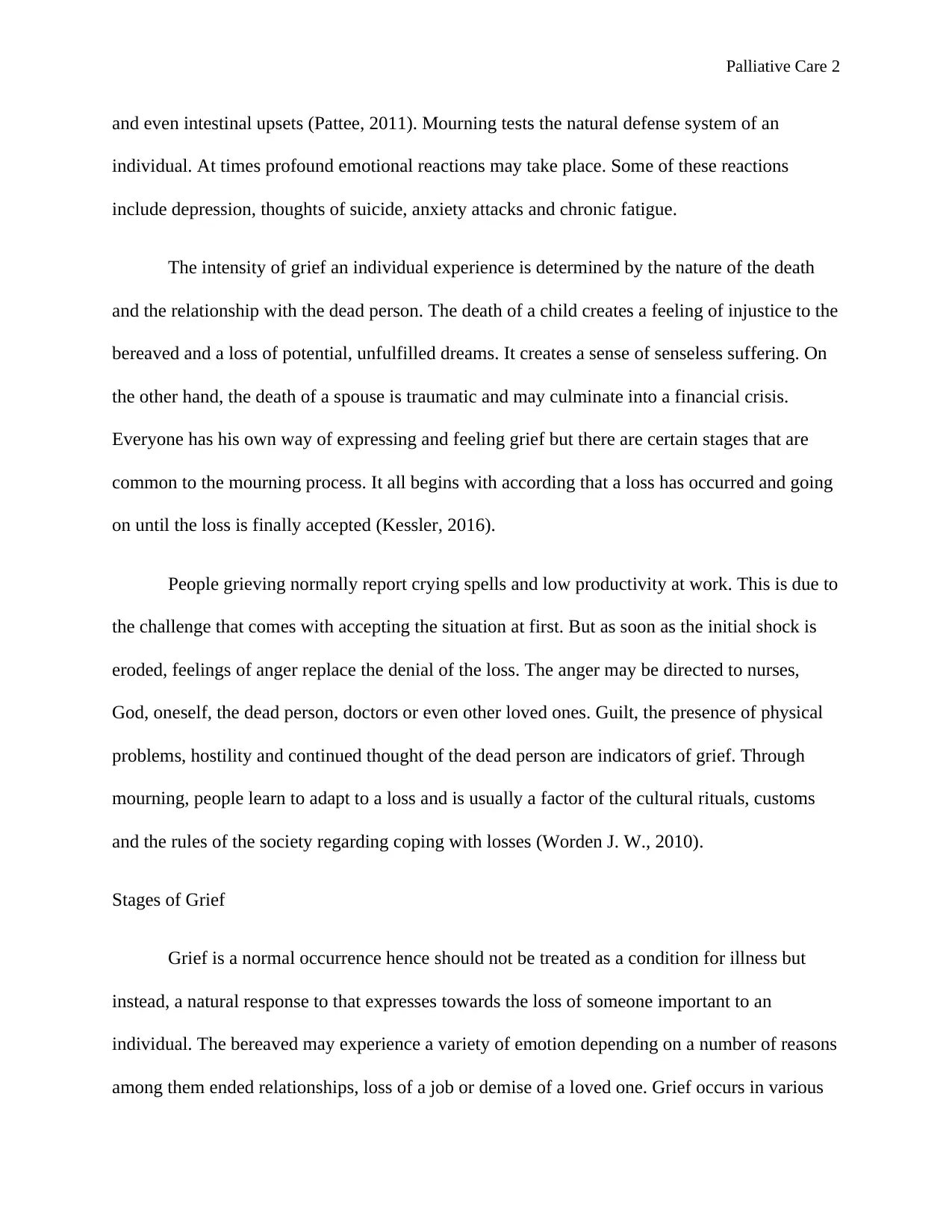
Palliative Care 2
and even intestinal upsets (Pattee, 2011). Mourning tests the natural defense system of an
individual. At times profound emotional reactions may take place. Some of these reactions
include depression, thoughts of suicide, anxiety attacks and chronic fatigue.
The intensity of grief an individual experience is determined by the nature of the death
and the relationship with the dead person. The death of a child creates a feeling of injustice to the
bereaved and a loss of potential, unfulfilled dreams. It creates a sense of senseless suffering. On
the other hand, the death of a spouse is traumatic and may culminate into a financial crisis.
Everyone has his own way of expressing and feeling grief but there are certain stages that are
common to the mourning process. It all begins with according that a loss has occurred and going
on until the loss is finally accepted (Kessler, 2016).
People grieving normally report crying spells and low productivity at work. This is due to
the challenge that comes with accepting the situation at first. But as soon as the initial shock is
eroded, feelings of anger replace the denial of the loss. The anger may be directed to nurses,
God, oneself, the dead person, doctors or even other loved ones. Guilt, the presence of physical
problems, hostility and continued thought of the dead person are indicators of grief. Through
mourning, people learn to adapt to a loss and is usually a factor of the cultural rituals, customs
and the rules of the society regarding coping with losses (Worden J. W., 2010).
Stages of Grief
Grief is a normal occurrence hence should not be treated as a condition for illness but
instead, a natural response to that expresses towards the loss of someone important to an
individual. The bereaved may experience a variety of emotion depending on a number of reasons
among them ended relationships, loss of a job or demise of a loved one. Grief occurs in various
and even intestinal upsets (Pattee, 2011). Mourning tests the natural defense system of an
individual. At times profound emotional reactions may take place. Some of these reactions
include depression, thoughts of suicide, anxiety attacks and chronic fatigue.
The intensity of grief an individual experience is determined by the nature of the death
and the relationship with the dead person. The death of a child creates a feeling of injustice to the
bereaved and a loss of potential, unfulfilled dreams. It creates a sense of senseless suffering. On
the other hand, the death of a spouse is traumatic and may culminate into a financial crisis.
Everyone has his own way of expressing and feeling grief but there are certain stages that are
common to the mourning process. It all begins with according that a loss has occurred and going
on until the loss is finally accepted (Kessler, 2016).
People grieving normally report crying spells and low productivity at work. This is due to
the challenge that comes with accepting the situation at first. But as soon as the initial shock is
eroded, feelings of anger replace the denial of the loss. The anger may be directed to nurses,
God, oneself, the dead person, doctors or even other loved ones. Guilt, the presence of physical
problems, hostility and continued thought of the dead person are indicators of grief. Through
mourning, people learn to adapt to a loss and is usually a factor of the cultural rituals, customs
and the rules of the society regarding coping with losses (Worden J. W., 2010).
Stages of Grief
Grief is a normal occurrence hence should not be treated as a condition for illness but
instead, a natural response to that expresses towards the loss of someone important to an
individual. The bereaved may experience a variety of emotion depending on a number of reasons
among them ended relationships, loss of a job or demise of a loved one. Grief occurs in various
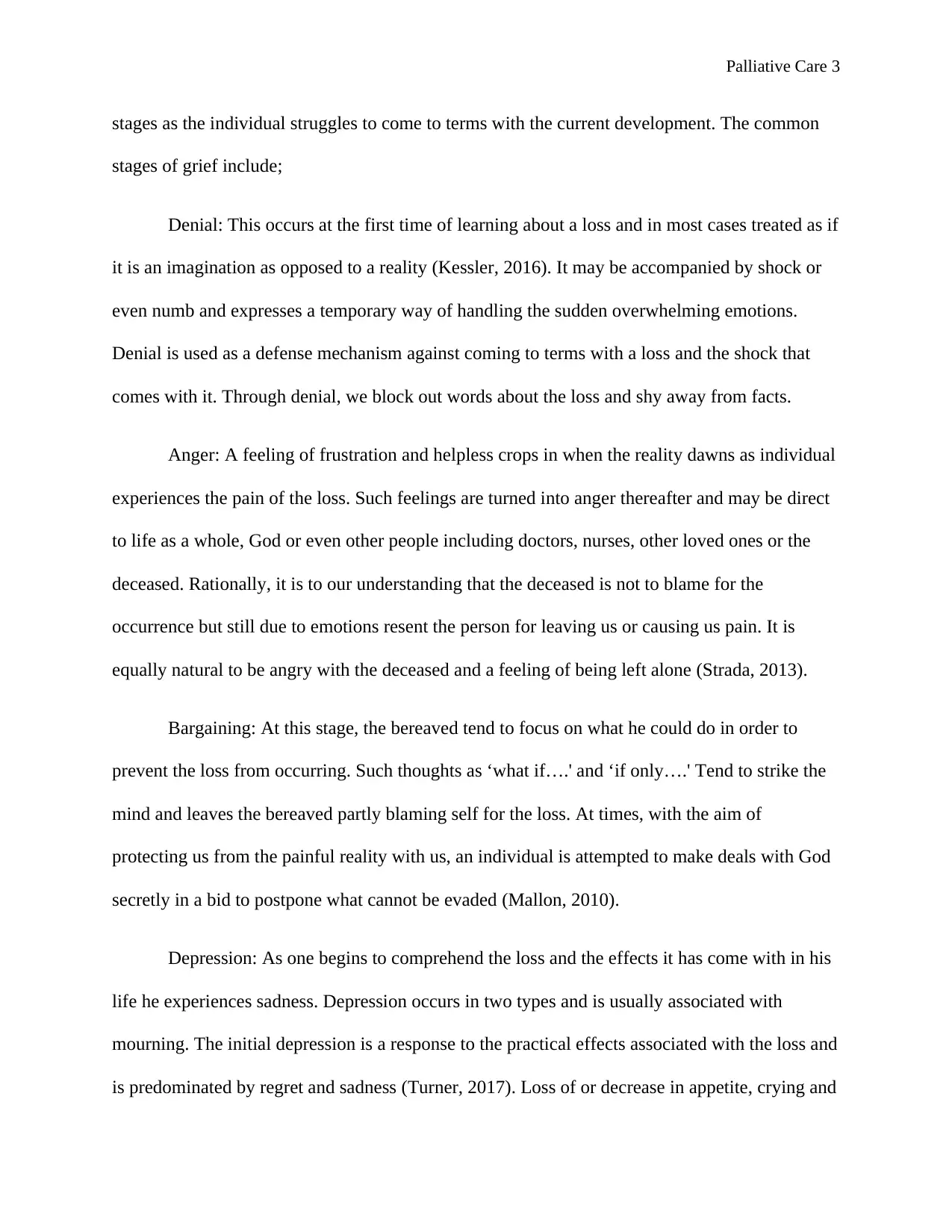
Palliative Care 3
stages as the individual struggles to come to terms with the current development. The common
stages of grief include;
Denial: This occurs at the first time of learning about a loss and in most cases treated as if
it is an imagination as opposed to a reality (Kessler, 2016). It may be accompanied by shock or
even numb and expresses a temporary way of handling the sudden overwhelming emotions.
Denial is used as a defense mechanism against coming to terms with a loss and the shock that
comes with it. Through denial, we block out words about the loss and shy away from facts.
Anger: A feeling of frustration and helpless crops in when the reality dawns as individual
experiences the pain of the loss. Such feelings are turned into anger thereafter and may be direct
to life as a whole, God or even other people including doctors, nurses, other loved ones or the
deceased. Rationally, it is to our understanding that the deceased is not to blame for the
occurrence but still due to emotions resent the person for leaving us or causing us pain. It is
equally natural to be angry with the deceased and a feeling of being left alone (Strada, 2013).
Bargaining: At this stage, the bereaved tend to focus on what he could do in order to
prevent the loss from occurring. Such thoughts as ‘what if….' and ‘if only….' Tend to strike the
mind and leaves the bereaved partly blaming self for the loss. At times, with the aim of
protecting us from the painful reality with us, an individual is attempted to make deals with God
secretly in a bid to postpone what cannot be evaded (Mallon, 2010).
Depression: As one begins to comprehend the loss and the effects it has come with in his
life he experiences sadness. Depression occurs in two types and is usually associated with
mourning. The initial depression is a response to the practical effects associated with the loss and
is predominated by regret and sadness (Turner, 2017). Loss of or decrease in appetite, crying and
stages as the individual struggles to come to terms with the current development. The common
stages of grief include;
Denial: This occurs at the first time of learning about a loss and in most cases treated as if
it is an imagination as opposed to a reality (Kessler, 2016). It may be accompanied by shock or
even numb and expresses a temporary way of handling the sudden overwhelming emotions.
Denial is used as a defense mechanism against coming to terms with a loss and the shock that
comes with it. Through denial, we block out words about the loss and shy away from facts.
Anger: A feeling of frustration and helpless crops in when the reality dawns as individual
experiences the pain of the loss. Such feelings are turned into anger thereafter and may be direct
to life as a whole, God or even other people including doctors, nurses, other loved ones or the
deceased. Rationally, it is to our understanding that the deceased is not to blame for the
occurrence but still due to emotions resent the person for leaving us or causing us pain. It is
equally natural to be angry with the deceased and a feeling of being left alone (Strada, 2013).
Bargaining: At this stage, the bereaved tend to focus on what he could do in order to
prevent the loss from occurring. Such thoughts as ‘what if….' and ‘if only….' Tend to strike the
mind and leaves the bereaved partly blaming self for the loss. At times, with the aim of
protecting us from the painful reality with us, an individual is attempted to make deals with God
secretly in a bid to postpone what cannot be evaded (Mallon, 2010).
Depression: As one begins to comprehend the loss and the effects it has come with in his
life he experiences sadness. Depression occurs in two types and is usually associated with
mourning. The initial depression is a response to the practical effects associated with the loss and
is predominated by regret and sadness (Turner, 2017). Loss of or decrease in appetite, crying and

Palliative Care 4
even sleep issues are the signs of depression that the bereaved is likely to experience. There may
be also feelings of loneliness, overwhelm and regrets. This depression can be eased by
reassurance and simple clarification through the use of a few kind words. The second depression
type is more private and subtle and involves a preparation to detach and bid our loved ones
farewell. At times a hug does significantly in improving this form of depression.
Acceptance: This the final stage of grief, one comes to terms with the loss experienced
and understands that the situation cannot be reversed (Worden J. W., 2013). At this stage, the
individual is able to move forward with life despite sadness resulting from the loss.
These stages of grief are experienced by every individual who experiences a loss even
though they may not be experienced in a logical manner. Some people may go through them in a
back and forth manner while others may skip or two of them. Such events as anniversaries tend
to remind of a loss and may, in turn, return the lost grief.
Worden's Four Tasks of Mourning
Worden, while explaining on the Four Tasks of Mourning in his book, he claims that there
are four tasks that an individual must accomplish in order to complete the mourning process and
the reestablishment of the equilibrium to occur (Mallon, 2010). He states that there is no order of
the four tasks but there exists a natural order of the completion such that the completion of one
culminates into the beginning of another. The four tasks include;
Admitting the actual occurrence of the loss
Understanding and accepting the pain of grief
Adjusting or adapting to an environment of non-existence of the deceased
even sleep issues are the signs of depression that the bereaved is likely to experience. There may
be also feelings of loneliness, overwhelm and regrets. This depression can be eased by
reassurance and simple clarification through the use of a few kind words. The second depression
type is more private and subtle and involves a preparation to detach and bid our loved ones
farewell. At times a hug does significantly in improving this form of depression.
Acceptance: This the final stage of grief, one comes to terms with the loss experienced
and understands that the situation cannot be reversed (Worden J. W., 2013). At this stage, the
individual is able to move forward with life despite sadness resulting from the loss.
These stages of grief are experienced by every individual who experiences a loss even
though they may not be experienced in a logical manner. Some people may go through them in a
back and forth manner while others may skip or two of them. Such events as anniversaries tend
to remind of a loss and may, in turn, return the lost grief.
Worden's Four Tasks of Mourning
Worden, while explaining on the Four Tasks of Mourning in his book, he claims that there
are four tasks that an individual must accomplish in order to complete the mourning process and
the reestablishment of the equilibrium to occur (Mallon, 2010). He states that there is no order of
the four tasks but there exists a natural order of the completion such that the completion of one
culminates into the beginning of another. The four tasks include;
Admitting the actual occurrence of the loss
Understanding and accepting the pain of grief
Adjusting or adapting to an environment of non-existence of the deceased
Secure Best Marks with AI Grader
Need help grading? Try our AI Grader for instant feedback on your assignments.
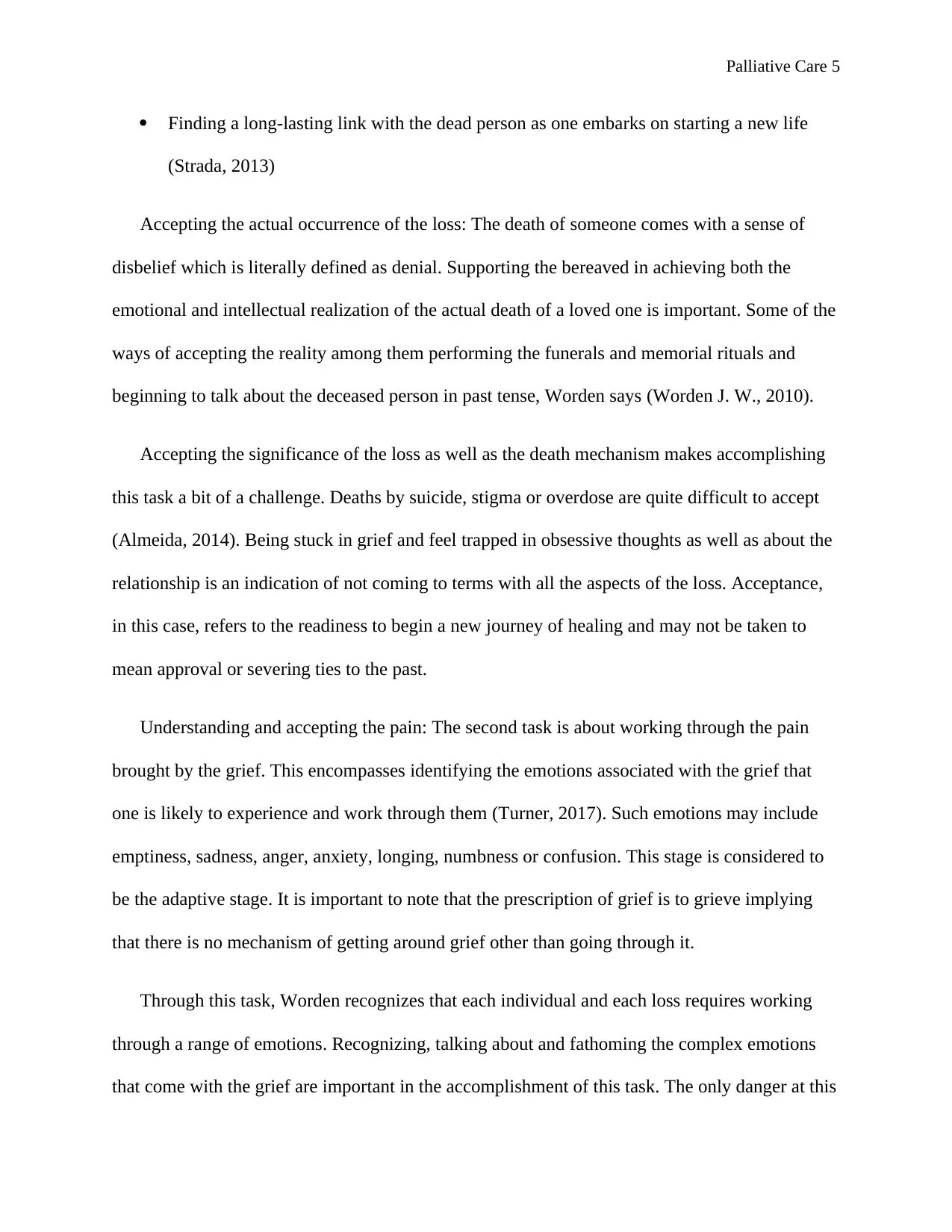
Palliative Care 5
Finding a long-lasting link with the dead person as one embarks on starting a new life
(Strada, 2013)
Accepting the actual occurrence of the loss: The death of someone comes with a sense of
disbelief which is literally defined as denial. Supporting the bereaved in achieving both the
emotional and intellectual realization of the actual death of a loved one is important. Some of the
ways of accepting the reality among them performing the funerals and memorial rituals and
beginning to talk about the deceased person in past tense, Worden says (Worden J. W., 2010).
Accepting the significance of the loss as well as the death mechanism makes accomplishing
this task a bit of a challenge. Deaths by suicide, stigma or overdose are quite difficult to accept
(Almeida, 2014). Being stuck in grief and feel trapped in obsessive thoughts as well as about the
relationship is an indication of not coming to terms with all the aspects of the loss. Acceptance,
in this case, refers to the readiness to begin a new journey of healing and may not be taken to
mean approval or severing ties to the past.
Understanding and accepting the pain: The second task is about working through the pain
brought by the grief. This encompasses identifying the emotions associated with the grief that
one is likely to experience and work through them (Turner, 2017). Such emotions may include
emptiness, sadness, anger, anxiety, longing, numbness or confusion. This stage is considered to
be the adaptive stage. It is important to note that the prescription of grief is to grieve implying
that there is no mechanism of getting around grief other than going through it.
Through this task, Worden recognizes that each individual and each loss requires working
through a range of emotions. Recognizing, talking about and fathoming the complex emotions
that come with the grief are important in the accomplishment of this task. The only danger at this
Finding a long-lasting link with the dead person as one embarks on starting a new life
(Strada, 2013)
Accepting the actual occurrence of the loss: The death of someone comes with a sense of
disbelief which is literally defined as denial. Supporting the bereaved in achieving both the
emotional and intellectual realization of the actual death of a loved one is important. Some of the
ways of accepting the reality among them performing the funerals and memorial rituals and
beginning to talk about the deceased person in past tense, Worden says (Worden J. W., 2010).
Accepting the significance of the loss as well as the death mechanism makes accomplishing
this task a bit of a challenge. Deaths by suicide, stigma or overdose are quite difficult to accept
(Almeida, 2014). Being stuck in grief and feel trapped in obsessive thoughts as well as about the
relationship is an indication of not coming to terms with all the aspects of the loss. Acceptance,
in this case, refers to the readiness to begin a new journey of healing and may not be taken to
mean approval or severing ties to the past.
Understanding and accepting the pain: The second task is about working through the pain
brought by the grief. This encompasses identifying the emotions associated with the grief that
one is likely to experience and work through them (Turner, 2017). Such emotions may include
emptiness, sadness, anger, anxiety, longing, numbness or confusion. This stage is considered to
be the adaptive stage. It is important to note that the prescription of grief is to grieve implying
that there is no mechanism of getting around grief other than going through it.
Through this task, Worden recognizes that each individual and each loss requires working
through a range of emotions. Recognizing, talking about and fathoming the complex emotions
that come with the grief are important in the accomplishment of this task. The only danger at this
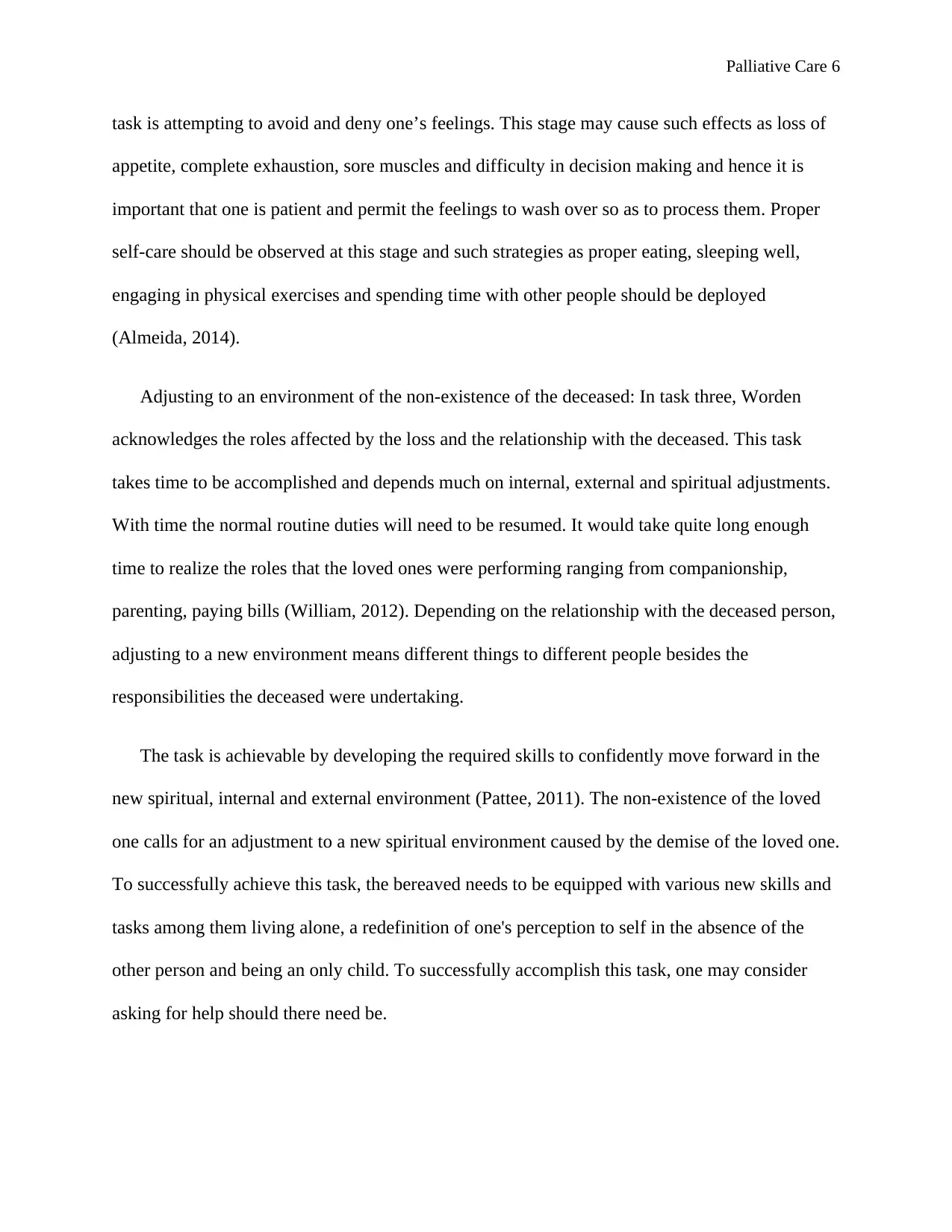
Palliative Care 6
task is attempting to avoid and deny one’s feelings. This stage may cause such effects as loss of
appetite, complete exhaustion, sore muscles and difficulty in decision making and hence it is
important that one is patient and permit the feelings to wash over so as to process them. Proper
self-care should be observed at this stage and such strategies as proper eating, sleeping well,
engaging in physical exercises and spending time with other people should be deployed
(Almeida, 2014).
Adjusting to an environment of the non-existence of the deceased: In task three, Worden
acknowledges the roles affected by the loss and the relationship with the deceased. This task
takes time to be accomplished and depends much on internal, external and spiritual adjustments.
With time the normal routine duties will need to be resumed. It would take quite long enough
time to realize the roles that the loved ones were performing ranging from companionship,
parenting, paying bills (William, 2012). Depending on the relationship with the deceased person,
adjusting to a new environment means different things to different people besides the
responsibilities the deceased were undertaking.
The task is achievable by developing the required skills to confidently move forward in the
new spiritual, internal and external environment (Pattee, 2011). The non-existence of the loved
one calls for an adjustment to a new spiritual environment caused by the demise of the loved one.
To successfully achieve this task, the bereaved needs to be equipped with various new skills and
tasks among them living alone, a redefinition of one's perception to self in the absence of the
other person and being an only child. To successfully accomplish this task, one may consider
asking for help should there need be.
task is attempting to avoid and deny one’s feelings. This stage may cause such effects as loss of
appetite, complete exhaustion, sore muscles and difficulty in decision making and hence it is
important that one is patient and permit the feelings to wash over so as to process them. Proper
self-care should be observed at this stage and such strategies as proper eating, sleeping well,
engaging in physical exercises and spending time with other people should be deployed
(Almeida, 2014).
Adjusting to an environment of the non-existence of the deceased: In task three, Worden
acknowledges the roles affected by the loss and the relationship with the deceased. This task
takes time to be accomplished and depends much on internal, external and spiritual adjustments.
With time the normal routine duties will need to be resumed. It would take quite long enough
time to realize the roles that the loved ones were performing ranging from companionship,
parenting, paying bills (William, 2012). Depending on the relationship with the deceased person,
adjusting to a new environment means different things to different people besides the
responsibilities the deceased were undertaking.
The task is achievable by developing the required skills to confidently move forward in the
new spiritual, internal and external environment (Pattee, 2011). The non-existence of the loved
one calls for an adjustment to a new spiritual environment caused by the demise of the loved one.
To successfully achieve this task, the bereaved needs to be equipped with various new skills and
tasks among them living alone, a redefinition of one's perception to self in the absence of the
other person and being an only child. To successfully accomplish this task, one may consider
asking for help should there need be.
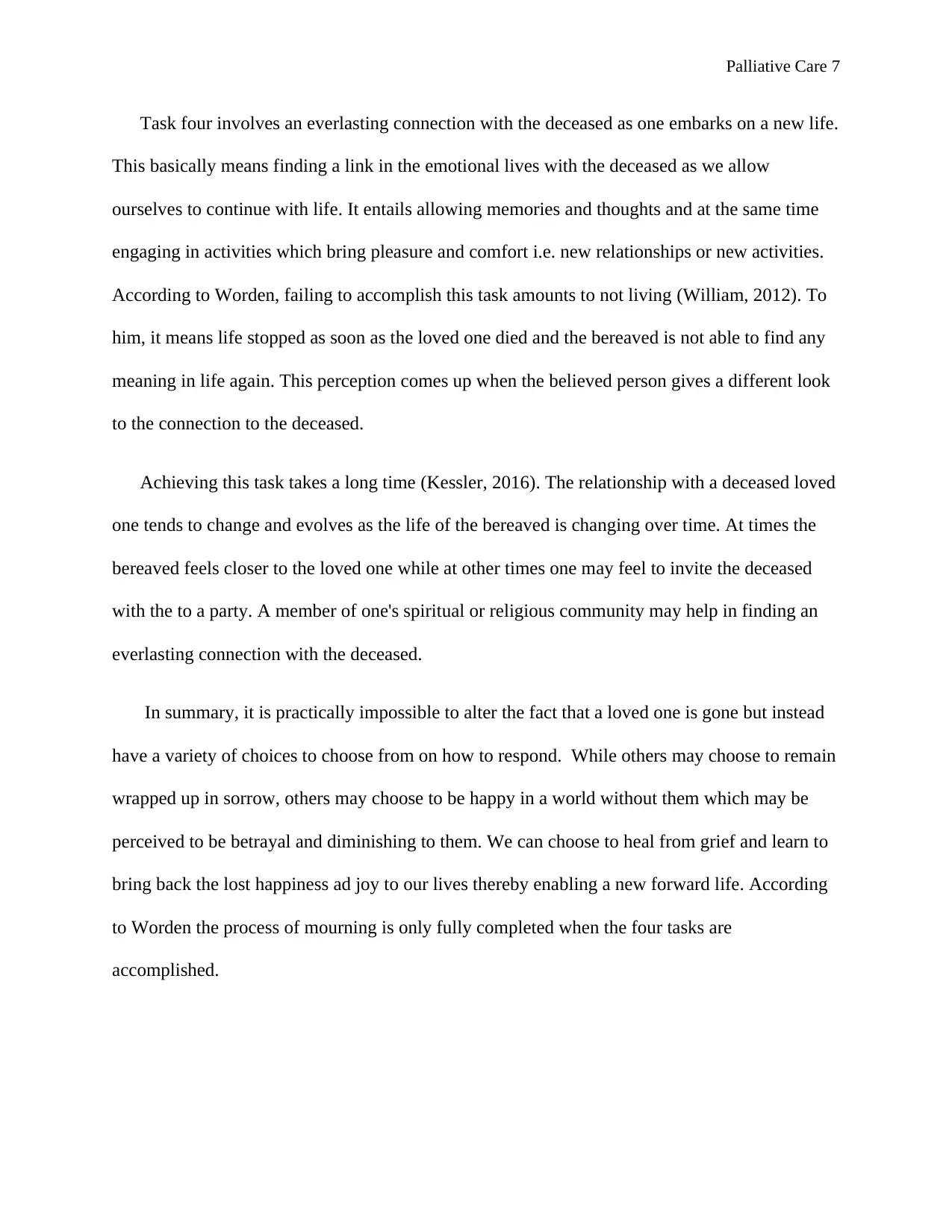
Palliative Care 7
Task four involves an everlasting connection with the deceased as one embarks on a new life.
This basically means finding a link in the emotional lives with the deceased as we allow
ourselves to continue with life. It entails allowing memories and thoughts and at the same time
engaging in activities which bring pleasure and comfort i.e. new relationships or new activities.
According to Worden, failing to accomplish this task amounts to not living (William, 2012). To
him, it means life stopped as soon as the loved one died and the bereaved is not able to find any
meaning in life again. This perception comes up when the believed person gives a different look
to the connection to the deceased.
Achieving this task takes a long time (Kessler, 2016). The relationship with a deceased loved
one tends to change and evolves as the life of the bereaved is changing over time. At times the
bereaved feels closer to the loved one while at other times one may feel to invite the deceased
with the to a party. A member of one's spiritual or religious community may help in finding an
everlasting connection with the deceased.
In summary, it is practically impossible to alter the fact that a loved one is gone but instead
have a variety of choices to choose from on how to respond. While others may choose to remain
wrapped up in sorrow, others may choose to be happy in a world without them which may be
perceived to be betrayal and diminishing to them. We can choose to heal from grief and learn to
bring back the lost happiness ad joy to our lives thereby enabling a new forward life. According
to Worden the process of mourning is only fully completed when the four tasks are
accomplished.
Task four involves an everlasting connection with the deceased as one embarks on a new life.
This basically means finding a link in the emotional lives with the deceased as we allow
ourselves to continue with life. It entails allowing memories and thoughts and at the same time
engaging in activities which bring pleasure and comfort i.e. new relationships or new activities.
According to Worden, failing to accomplish this task amounts to not living (William, 2012). To
him, it means life stopped as soon as the loved one died and the bereaved is not able to find any
meaning in life again. This perception comes up when the believed person gives a different look
to the connection to the deceased.
Achieving this task takes a long time (Kessler, 2016). The relationship with a deceased loved
one tends to change and evolves as the life of the bereaved is changing over time. At times the
bereaved feels closer to the loved one while at other times one may feel to invite the deceased
with the to a party. A member of one's spiritual or religious community may help in finding an
everlasting connection with the deceased.
In summary, it is practically impossible to alter the fact that a loved one is gone but instead
have a variety of choices to choose from on how to respond. While others may choose to remain
wrapped up in sorrow, others may choose to be happy in a world without them which may be
perceived to be betrayal and diminishing to them. We can choose to heal from grief and learn to
bring back the lost happiness ad joy to our lives thereby enabling a new forward life. According
to Worden the process of mourning is only fully completed when the four tasks are
accomplished.
Paraphrase This Document
Need a fresh take? Get an instant paraphrase of this document with our AI Paraphraser
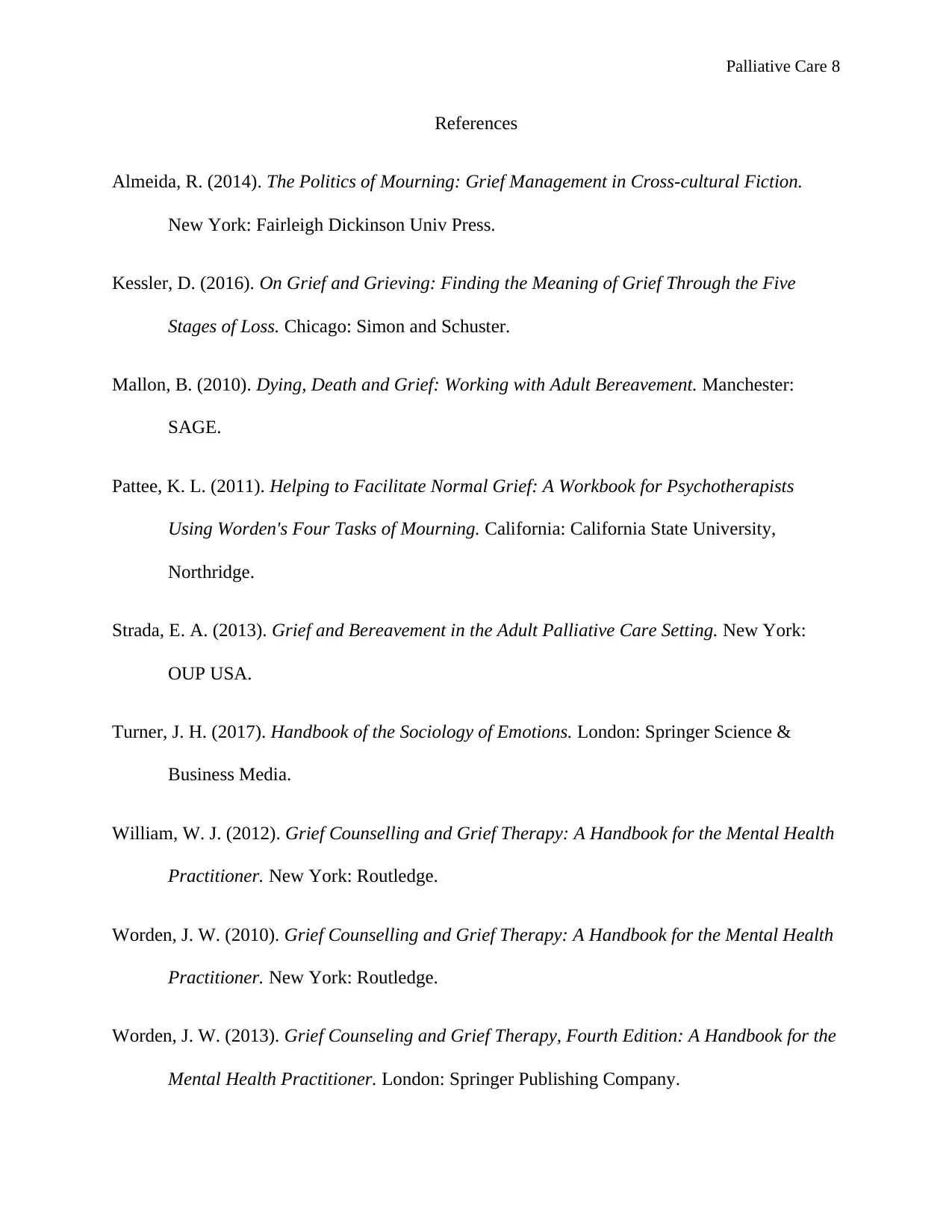
Palliative Care 8
References
Almeida, R. (2014). The Politics of Mourning: Grief Management in Cross-cultural Fiction.
New York: Fairleigh Dickinson Univ Press.
Kessler, D. (2016). On Grief and Grieving: Finding the Meaning of Grief Through the Five
Stages of Loss. Chicago: Simon and Schuster.
Mallon, B. (2010). Dying, Death and Grief: Working with Adult Bereavement. Manchester:
SAGE.
Pattee, K. L. (2011). Helping to Facilitate Normal Grief: A Workbook for Psychotherapists
Using Worden's Four Tasks of Mourning. California: California State University,
Northridge.
Strada, E. A. (2013). Grief and Bereavement in the Adult Palliative Care Setting. New York:
OUP USA.
Turner, J. H. (2017). Handbook of the Sociology of Emotions. London: Springer Science &
Business Media.
William, W. J. (2012). Grief Counselling and Grief Therapy: A Handbook for the Mental Health
Practitioner. New York: Routledge.
Worden, J. W. (2010). Grief Counselling and Grief Therapy: A Handbook for the Mental Health
Practitioner. New York: Routledge.
Worden, J. W. (2013). Grief Counseling and Grief Therapy, Fourth Edition: A Handbook for the
Mental Health Practitioner. London: Springer Publishing Company.
References
Almeida, R. (2014). The Politics of Mourning: Grief Management in Cross-cultural Fiction.
New York: Fairleigh Dickinson Univ Press.
Kessler, D. (2016). On Grief and Grieving: Finding the Meaning of Grief Through the Five
Stages of Loss. Chicago: Simon and Schuster.
Mallon, B. (2010). Dying, Death and Grief: Working with Adult Bereavement. Manchester:
SAGE.
Pattee, K. L. (2011). Helping to Facilitate Normal Grief: A Workbook for Psychotherapists
Using Worden's Four Tasks of Mourning. California: California State University,
Northridge.
Strada, E. A. (2013). Grief and Bereavement in the Adult Palliative Care Setting. New York:
OUP USA.
Turner, J. H. (2017). Handbook of the Sociology of Emotions. London: Springer Science &
Business Media.
William, W. J. (2012). Grief Counselling and Grief Therapy: A Handbook for the Mental Health
Practitioner. New York: Routledge.
Worden, J. W. (2010). Grief Counselling and Grief Therapy: A Handbook for the Mental Health
Practitioner. New York: Routledge.
Worden, J. W. (2013). Grief Counseling and Grief Therapy, Fourth Edition: A Handbook for the
Mental Health Practitioner. London: Springer Publishing Company.

Palliative Care 9
1 out of 9
Related Documents
Your All-in-One AI-Powered Toolkit for Academic Success.
+13062052269
info@desklib.com
Available 24*7 on WhatsApp / Email
![[object Object]](/_next/static/media/star-bottom.7253800d.svg)
Unlock your academic potential
© 2024 | Zucol Services PVT LTD | All rights reserved.





